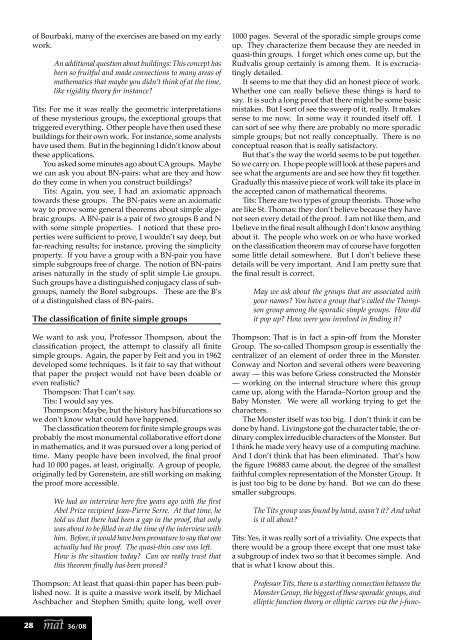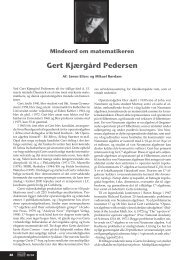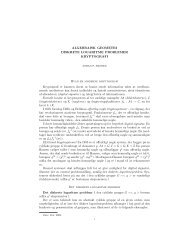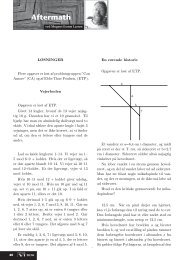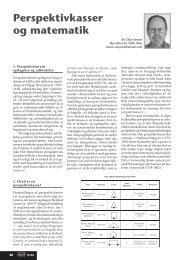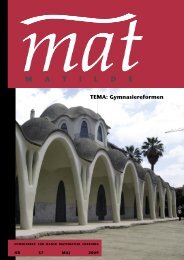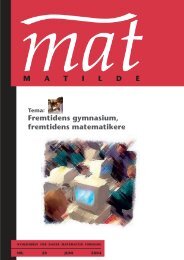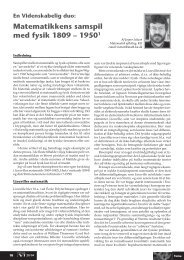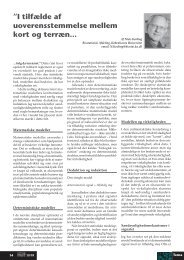Tema: Rekreativ matematik - Matilde - Dansk Matematisk Forening
Tema: Rekreativ matematik - Matilde - Dansk Matematisk Forening
Tema: Rekreativ matematik - Matilde - Dansk Matematisk Forening
Create successful ePaper yourself
Turn your PDF publications into a flip-book with our unique Google optimized e-Paper software.
of Bourbaki, many of the exercises are based on my early<br />
work.<br />
An additional question about buildings: This concept has<br />
been so fruitful and made connections to many areas of<br />
mathematics that maybe you didn’t think of at the time,<br />
like rigidity theory for instance?<br />
Tits: For me it was really the geometric interpretations<br />
of these mysterious groups, the exceptional groups that<br />
triggered everything. Other people have then used these<br />
buildings for their own work. For instance, some analysts<br />
have used them. But in the beginning I didn’t know about<br />
these applications.<br />
You asked some minutes ago about CA groups. Maybe<br />
we can ask you about BN-pairs: what are they and how<br />
do they come in when you construct buildings?<br />
Tits: Again, you see, I had an axiomatic approach<br />
towards these groups. The BN-pairs were an axiomatic<br />
way to prove some general theorems about simple algebraic<br />
groups. A BN-pair is a pair of two groups B and N<br />
with some simple properties. I noticed that these properties<br />
were sufficient to prove, I wouldn’t say deep, but<br />
far-reaching results; for instance, proving the simplicity<br />
property. If you have a group with a BN-pair you have<br />
simple subgroups free of charge. The notion of BN-pairs<br />
arises naturally in the study of split simple Lie groups.<br />
Such groups have a distinguished conjugacy class of subgroups,<br />
namely the Borel subgroups. These are the B’s<br />
of a distinguished class of BN-pairs.<br />
The classification of finite simple groups<br />
We want to ask you, Professor Thompson, about the<br />
classification project, the attempt to classify all finite<br />
simple groups. Again, the paper by Feit and you in 1962<br />
developed some techniques. Is it fair to say that without<br />
that paper the project would not have been doable or<br />
even realistic?<br />
Thompson: That I can’t say.<br />
Tits: I would say yes.<br />
Thompson: Maybe, but the history has bifurcations so<br />
we don’t know what could have happened.<br />
The classification theorem for finite simple groups was<br />
probably the most monumental collaborative effort done<br />
in mathematics, and it was pursued over a long period of<br />
time. Many people have been involved, the final proof<br />
had 10 000 pages, at least, originally. A group of people,<br />
originally led by Gorenstein, are still working on making<br />
the proof more accessible.<br />
We had an interview here five years ago with the first<br />
Abel Prize recipient Jean-Pierre Serre. At that time, he<br />
told us that there had been a gap in the proof, that only<br />
was about to be filled in at the time of the interview with<br />
him. Before, it would have been premature to say that one<br />
actually had the proof. The quasi-thin case was left.<br />
How is the situation today? Can we really trust that<br />
this theorem finally has been proved?<br />
Thompson: At least that quasi-thin paper has been published<br />
now. It is quite a massive work itself, by Michael<br />
Aschbacher and Stephen Smith; quite long, well over<br />
28 36/08<br />
1000 pages. Several of the sporadic simple groups come<br />
up. They characterize them because they are needed in<br />
quasi-thin groups. I forget which ones come up, but the<br />
Rudvalis group certainly is among them. It is excruciatingly<br />
detailed.<br />
It seems to me that they did an honest piece of work.<br />
Whether one can really believe these things is hard to<br />
say. It is such a long proof that there might be some basic<br />
mistakes. But I sort of see the sweep of it, really. It makes<br />
sense to me now. In some way it rounded itself off. I<br />
can sort of see why there are probably no more sporadic<br />
simple groups; but not really conceptually. There is no<br />
conceptual reason that is really satisfactory.<br />
But that’s the way the world seems to be put together.<br />
So we carry on. I hope people will look at these papers and<br />
see what the arguments are and see how they fit together.<br />
Gradually this massive piece of work will take its place in<br />
the accepted canon of mathematical theorems.<br />
Tits: There are two types of group theorists. Those who<br />
are like St. Thomas: they don’t believe because they have<br />
not seen every detail of the proof. I am not like them, and<br />
I believe in the final result although I don’t know anything<br />
about it. The people who work on or who have worked<br />
on the classification theorem may of course have forgotten<br />
some little detail somewhere. But I don’t believe these<br />
details will be very important. And I am pretty sure that<br />
the final result is correct.<br />
May we ask about the groups that are associated with<br />
your names? You have a group that’s called the Thompson<br />
group among the sporadic simple groups. How did<br />
it pop up? How were you involved in finding it?<br />
Thompson: That is in fact a spin-off from the Monster<br />
Group. The so-called Thompson group is essentially the<br />
centralizer of an element of order three in the Monster.<br />
Conway and Norton and several others were beavering<br />
away — this was before Griess constructed the Monster<br />
— working on the internal structure where this group<br />
came up, along with the Harada–Norton group and the<br />
Baby Monster. We were all working trying to get the<br />
characters.<br />
The Monster itself was too big. I don’t think it can be<br />
done by hand. Livingstone got the character table, the ordinary<br />
complex irreducible characters of the Monster. But<br />
I think he made very heavy use of a computing machine.<br />
And I don’t think that has been eliminated. That’s how<br />
the figure 196883 came about, the degree of the smallest<br />
faithful complex representation of the Monster Group. It<br />
is just too big to be done by hand. But we can do these<br />
smaller subgroups.<br />
The Tits group was found by hand, wasn’t it? And what<br />
is it all about?<br />
Tits: Yes, it was really sort of a triviality. One expects that<br />
there would be a group there except that one must take<br />
a subgroup of index two so that it becomes simple. And<br />
that is what I know about this.<br />
Professor Tits, there is a startling connection between the<br />
Monster Group, the biggest of these sporadic groups, and<br />
elliptic function theory or elliptic curves via the j-func-


